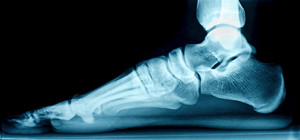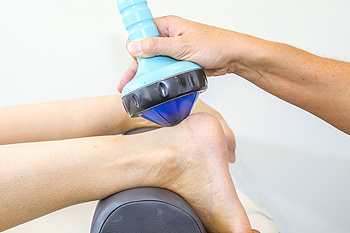Items filtered by date: October 2020
Do I Have Flexible or Rigid Flat Feet?
 Flat feet is a condition in which the arch, the curved middle part of the bottom of the foot, is absent or has collapsed. The lack of an arch causes the entire sole of the foot to make direct contact with the ground when walking or standing. There are actually two types of flat feet that differ slightly from one another. Flexible flat feet have the ability to form an arch, but this arch flattens when any weight is put on the foot. However, the arch is visible when you are sitting down or holding your foot up in the air. This is the most common type of flat foot. Rigid flat feet cannot form an arch, regardless of whether or not weight is placed on them. While most cases of flat foot do not require medical intervention, sometimes this condition can cause pain or discomfort. In those cases, it is recommended that you see a podiatrist for treatment.
Flat feet is a condition in which the arch, the curved middle part of the bottom of the foot, is absent or has collapsed. The lack of an arch causes the entire sole of the foot to make direct contact with the ground when walking or standing. There are actually two types of flat feet that differ slightly from one another. Flexible flat feet have the ability to form an arch, but this arch flattens when any weight is put on the foot. However, the arch is visible when you are sitting down or holding your foot up in the air. This is the most common type of flat foot. Rigid flat feet cannot form an arch, regardless of whether or not weight is placed on them. While most cases of flat foot do not require medical intervention, sometimes this condition can cause pain or discomfort. In those cases, it is recommended that you see a podiatrist for treatment.
Flatfoot is a condition many people suffer from. If you have flat feet, contact Dr. Douglas Mckay from New Jersey . Our doctor will treat your foot and ankle needs.
What Are Flat Feet?
Flatfoot is a condition in which the arch of the foot is depressed and the sole of the foot is almost completely in contact with the ground. About 20-30% of the population generally has flat feet because their arches never formed during growth.
Conditions & Problems:
Having flat feet makes it difficult to run or walk because of the stress placed on the ankles.
Alignment – The general alignment of your legs can be disrupted, because the ankles move inward which can cause major discomfort.
Knees – If you have complications with your knees, flat feet can be a contributor to arthritis in that area.
Symptoms
- Pain around the heel or arch area
- Trouble standing on the tip toe
- Swelling around the inside of the ankle
- Flat look to one or both feet
- Having your shoes feel uneven when worn
Treatment
If you are experiencing pain and stress on the foot you may weaken the posterior tibial tendon, which runs around the inside of the ankle.
If you have any questions please feel free to contact one of our offices located in Caldwell, and Galloway, NJ . We offer the newest diagnostic and treatment technologies for all your foot and ankle needs.
Possible Conditions Shockwave Therapy Can Treat
 The medical procedure that is known as shockwave therapy may be helpful in monitoring chronic foot pain. Shockwave therapy is a type of non-invasive therapy which may accelerate the healing process. It is administered by a machine that delivers high-energy sound waves. This procedure generally causes little or no pain, in addition to minimal time missed from work and other activities. The conditions that are commonly treated with shockwave therapy can include plantar fasciitis, ankle discomfort, and general foot pain. If you are suffering with chronic foot pain, it is strongly suggested that you are under the care of a podiatrist who can discuss the benefits of shockwave therapy with you.
The medical procedure that is known as shockwave therapy may be helpful in monitoring chronic foot pain. Shockwave therapy is a type of non-invasive therapy which may accelerate the healing process. It is administered by a machine that delivers high-energy sound waves. This procedure generally causes little or no pain, in addition to minimal time missed from work and other activities. The conditions that are commonly treated with shockwave therapy can include plantar fasciitis, ankle discomfort, and general foot pain. If you are suffering with chronic foot pain, it is strongly suggested that you are under the care of a podiatrist who can discuss the benefits of shockwave therapy with you.
Shockwave therapy is a treatment commonly used to treat various injuries and conditions, particularly plantar fasciitis in the feet. To learn more, consult with Dr. Douglas Mckay from New Jersey . Our doctor can provide the care you need to keep you pain-free and on your feet.
Shockwave Therapy
Shockwave therapy is a new treatment option designed to treat bone conditions such as tennis elbow, shoulder pain, and others. Shockwave therapy uses high intensity sound waves that are directed to the affected tissues of the body with pinpoint accuracy. The effects are very beneficial, leading to a production of collagen fibers, eliminating inflammation.
Who Benefits from Shockwave?
Shockwave is recommended for patients suffering from heel pain and associated problems. Heel pain is a common condition which can be caused by obesity, overexertion, and spending a substantial amount of time on hard floors with your feet exposed and unsupported.
Fast and Easy
The therapy is actually a simple process that can leave patients feeling better the very next day. Shockwave therapy is not as dramatic as it sounds. It enables more blood flow to effected areas, addressing the source of the problem and allowing treatment to last for a long time.
Treatment & Recovery Time
Shockwave treatment will enable your feet to recover quickly. This is especially important since surgery is not required. It is cost effective and does not require the use of anesthesia. This treatment is a better option to surgery, since it is proven safe.
If you have any questions, please feel free to contact one of our offices located in Caldwell, and Galloway, NJ . We offer the newest diagnostic and treatment technologies for all your foot and ankle needs.
What Can Cause a Foot Blister?
 A blister is a fluid-filled pocket that forms on the outer layer of skin. The blister exists to protect and cushion the layers of skin below, so popping it is not recommended. Many people get blisters on their feet. This is typically due to friction from footwear rubbing repeatedly against the skin. Other causes of blisters include exposure to extreme temperatures, exposure to certain chemicals, crushing and pinching of blood vessels near the surface of the skin, and medical conditions such as chicken pox, eczema, and dyshidrosis. If you have a painful foot blister, it is recommended that you visit a podiatrist for treatment.
A blister is a fluid-filled pocket that forms on the outer layer of skin. The blister exists to protect and cushion the layers of skin below, so popping it is not recommended. Many people get blisters on their feet. This is typically due to friction from footwear rubbing repeatedly against the skin. Other causes of blisters include exposure to extreme temperatures, exposure to certain chemicals, crushing and pinching of blood vessels near the surface of the skin, and medical conditions such as chicken pox, eczema, and dyshidrosis. If you have a painful foot blister, it is recommended that you visit a podiatrist for treatment.
Blisters are prone to making everyday activities extremely uncomfortable. If your feet are hurting, contact Dr. Douglas Mckay of New Jersey . Our doctor can provide the care you need to keep you pain-free and on your feet.
Foot Blisters
Foot blisters develop as a result of constantly wearing tight or ill-fitting footwear. This happens due to the constant rubbing from the shoe, which can often lead to pain.
What Are Foot Blisters?
A foot blister is a small fluid-filled pocket that forms on the upper-most layer of the skin. Blisters are filled with clear fluid and can lead to blood drainage or pus if the area becomes infected.
How Do Blisters Form?
Blisters on the feet are often the result of constant friction of skin and material, usually by shoe rubbing. Walking in sandals, boots, or shoes that don’t fit properly for long periods of time can result in a blister. Having consistent foot moisture and humidity can easily lead to blister formation.
Prevention & Treatment
It is important to properly care for the affected area in order to prevent infection and ease the pain. Do not lance the blister and use a Band-Aid to provide pain relief. Also, be sure to keep your feet dry and wear proper fitting shoes. If you see blood or pus in a blister, seek assistance from a podiatrist.
If you have any questions, please feel free to contact one of our offices located in Caldwell, and Galloway, NJ . We offer the newest diagnostic and treatment technologies for all your foot care needs.
How Do Stress Fractures Occur?
 Stress fractures are small hairline fractures that usually occur due to the foot no longer being able to handle the load being placed on it. This is a common result of overuse and repetitive motion, and leads to an increased risk of stress fractures for athletes such as runners, soccer players and dancers. Those who suffer from health problems such as osteoporosis or an abnormal gait are also at a higher risk for developing a stress fracture. While stress fractures can happen in any bone in the foot, they most commonly occur in 3 places: the metatarsal bones (near the mid foot), the calcaneus bone (or heel bone), or the navicular bone (top of the foot). Common symptoms of a stress fracture include tenderness, pain deep in the foot, weakness, intermittent pain, changes in foot biomechanics, sharp pain, swelling and bruising. If you are experiencing these symptoms, it is important to consult with a podiatrist for proper diagnosis and treatment.
Stress fractures are small hairline fractures that usually occur due to the foot no longer being able to handle the load being placed on it. This is a common result of overuse and repetitive motion, and leads to an increased risk of stress fractures for athletes such as runners, soccer players and dancers. Those who suffer from health problems such as osteoporosis or an abnormal gait are also at a higher risk for developing a stress fracture. While stress fractures can happen in any bone in the foot, they most commonly occur in 3 places: the metatarsal bones (near the mid foot), the calcaneus bone (or heel bone), or the navicular bone (top of the foot). Common symptoms of a stress fracture include tenderness, pain deep in the foot, weakness, intermittent pain, changes in foot biomechanics, sharp pain, swelling and bruising. If you are experiencing these symptoms, it is important to consult with a podiatrist for proper diagnosis and treatment.
Stress fractures occur when there is a tiny crack within a bone. To learn more, contact Dr. Douglas Mckay from New Jersey . Our doctor can provide the care you need to keep you pain free and on your feet.
How Are They Caused?
Stress fractures are the result of repetitive force being placed on the bone. Since the lower leg and feet often carry most of the body’s weight, stress fractures are likely to occur in these areas. If you rush into a new exercise, you are more likely to develop a stress fracture since you are starting too much, too soon. Pain resulting from stress fractures may go unnoticed at first, however it may start to worsen over time.
Risk Factors
- Gender – They are more commonly found in women compared to men.
- Foot Problems – People with unusual arches in their feet are more likely to develop stress fractures.
- Certain Sports – Dancers, gymnasts, tennis players, runners, and basketball players are more likely to develop stress fractures.
- Lack of Nutrients – A lack of vitamin D and calcium may weaken the bones and make you more prone to stress fractures
- Weak Bones – Osteoporosis can weaken the bones therefore resulting in stress fractures
Stress fractures do not always heal properly, so it is important that you seek help from a podiatrist if you suspect you may have one. Ignoring your stress fracture may cause it to worsen, and you may develop chronic pain as well as additional fractures.
If you have any questions, please feel free to contact one of our offices located in Caldwell, and Galloway, NJ . We offer the newest diagnostic and treatment technologies for all your foot care needs.


